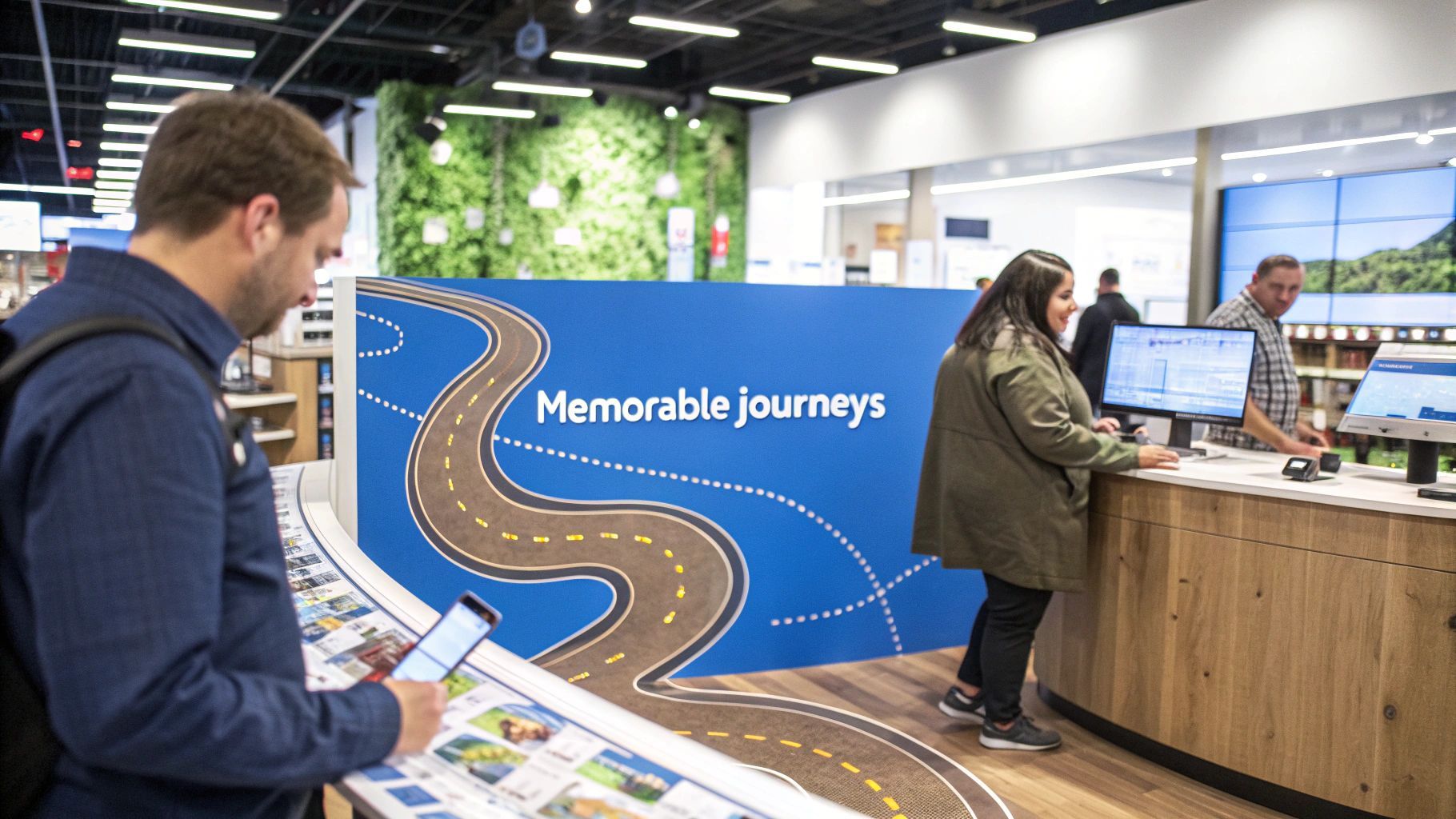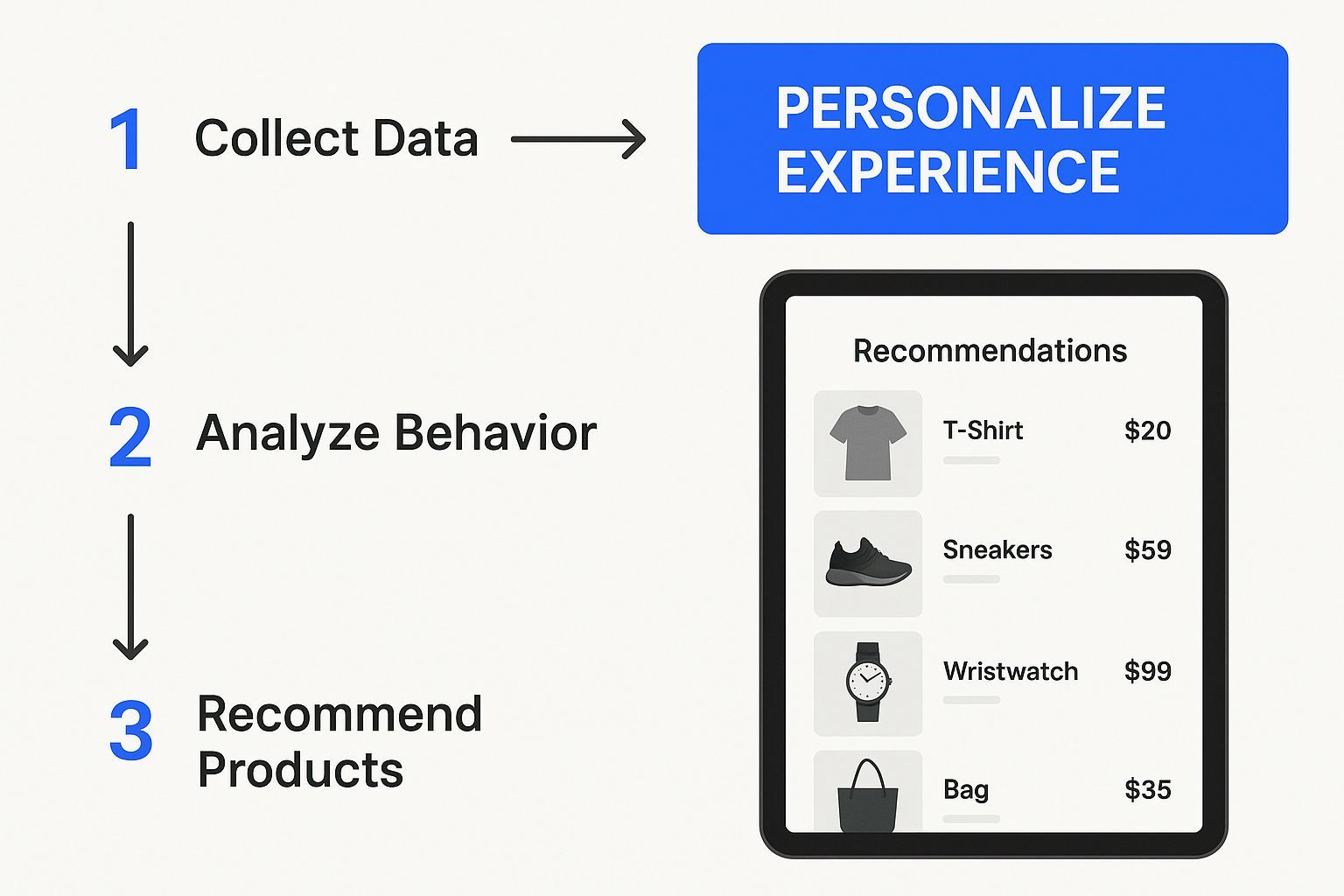
Customer Experience Design: Create Memorable Journeys
Discuss with AI
Get instant insights and ask questions about this topic with AI assistants.
💡 Pro tip: All options include context about this blog post. Feel free to modify the prompt to ask more specific questions!

Think about the last time you told a friend about a great brand. Did you recommend them because their prices were rock-bottom? Probably not. More likely, you shared your experience – how easy their website was to use, how helpful their customer service team was, or simply how much you loved their product. That, in a nutshell, is the power of customer experience design (CX design): thoughtfully crafting every interaction a customer has with your brand to build a positive and memorable connection.
This focus on experience is transforming the business world. Instead of obsessing over product features alone, companies are investing in truly understanding their customers' journeys – and we're not just talking demographics and purchase history. They're exploring deeper questions: What are our customers' worries and desires? How can we make them feel valued and understood?
This isn't a passing fad; it's a fundamental shift in the competitive landscape. Traditionally, businesses battled it out on product features and price. Those factors still matter, of course, but they’re no longer enough. Customers today have a dizzying array of choices. They're not just buying a product; they're buying an entire experience.
That’s why CX design is so vital. By creating amazing experiences, businesses can forge stronger customer relationships, build loyalty, and boost revenue. This is reflected in the growing importance businesses place on CX. By 2025, an astounding 89% of businesses are predicted to compete mainly on customer experience, leaving traditional factors like product and price in the dust. Discover more insights. This shift demonstrates that positive experiences are no longer a bonus, but a core business necessity.
Successfully implementing CX design isn't about making a few surface-level changes. It requires a complete overhaul of your company culture, building a truly customer-centric organization. This means weaving customer-focused thinking into every department, from product development and marketing to customer service.
For social media management tools, check out the Postiz Homepage. Understanding the customer journey is also essential. This involves mapping every single touchpoint a customer has with your brand, from their first encounter to long after they've made a purchase. Then, you pinpoint opportunities to improve the experience at each stage. This includes online and offline interactions, creating a complete picture of the customer relationship. By looking at the whole journey, businesses can identify pain points, personalize interactions, and build a consistent, positive experience that fosters loyalty and turns customers into brand advocates. The result? Higher customer lifetime value and sustainable business growth.
Think of a truly memorable experience, like a favorite concert or a delicious meal. What made it stick with you? Likely, it was a combination of factors, perfectly orchestrated to create something special. That's the essence of great customer experience (CX) design: a carefully crafted journey across every touchpoint. Let's explore the key components that elevate experiences from ordinary to exceptional.
Imagine your go-to restaurant. You appreciate the consistently delicious food, but also the server who remembers your usual drink order. This blend of consistency and personalization is the heart of CX design. Customers value reliability – knowing what to expect builds trust. But they also crave individual recognition. Think of Netflix: their interface is consistently easy to navigate, yet their recommendations are tailored to your viewing history. This balance creates a sense of both familiarity and personal attention.
While efficiency is essential, sometimes a touch of delight can make all the difference. Consider the difference between a self-service gas pump and a full-service station. The self-service option is quick, but impersonal. A friendly attendant offering to wash your windshield can transform a mundane task into a positive interaction. Similarly, a small gift with an online order can turn a transaction into a memorable moment. Knowing when to streamline for efficiency and when to inject a little something extra is a hallmark of excellent CX design.
Behind every seemingly effortless experience lies a complex web of design decisions. Think of Airbnb. With a few clicks, you can find a place to stay, book it, and communicate with the host. This simplicity hides the intricate technology and processes working behind the scenes. Great CX design anticipates customer needs, removes obstacles, and makes interactions feel intuitive and smooth. Managing customer expectations is critical to this process – check out this helpful resource: 10 Tips To Managing Customer Expectations.
Exceptional CX design goes beyond functional needs to consider the emotional journey of the customer. How a brand makes you feel often resonates longer than what they sell. Disney excels at this. Every detail, from the park layout to the character interactions, is designed to evoke specific emotions like joy, wonder, and magic. Mapping these emotional touchpoints alongside functional ones allows businesses to create deeply resonant experiences that build lasting connections. Investing in excellent customer service can also greatly enhance this emotional connection – take a look at this guide on customer service skills training.
To illustrate how different design elements contribute to a positive customer experience and benefit the business, let's look at a comparison table:
Core Elements of Customer Experience Design
Comparison of key CX design components and their impact on customer satisfaction
Design Element Customer Impact Business Benefit Implementation Difficulty Personalized recommendations Increased engagement and loyalty Higher conversion rates and repeat purchases Moderate, requires data analysis and integration Seamless checkout process Reduced frustration and increased convenience Improved sales and reduced cart abandonment Moderate, requires careful design and testing Proactive customer support Increased satisfaction and trust Improved customer retention and positive word-of-mouth High, requires dedicated resources and training Omnichannel consistency Seamless brand experience across all touchpoints Strengthened brand identity and customer loyalty High, requires integration and coordination across multiple channels Surprise and delight elements Increased positive emotions and brand affinity Improved customer loyalty and brand advocacy Low to moderate, requires creativity and planning
This table summarizes how different aspects of CX design contribute to both customer satisfaction and business success. While some elements may be more challenging to implement, the potential rewards in terms of customer loyalty and business growth make the effort worthwhile.
By understanding these essential elements, businesses can move beyond simply meeting customer needs. They can create truly exceptional experiences that foster lasting loyalty and drive significant growth.
Forget static diagrams. Effective customer journey mapping is a dynamic process, like exploring a hidden landscape. It’s about understanding not just what customers do, but the why behind their actions. This section explores proven methods to uncover what customers think, feel, and need at each step, transforming those insights into real improvements.
Customer experience design depends on truly understanding your customer. A crucial first step is visualizing their journey with your brand. This isn't about creating a pretty flowchart; it's about meticulous detective work. Visual appeal still matters; for instance, getting your Shopify banner image size right is crucial for first impressions. Take a look at this infographic on personalization within the customer journey:

The infographic shows a dashboard with personalized product recommendations. This highlights how tailoring the experience to each individual’s preferences can boost engagement and drive conversions. It moves away from a generic approach to a more customer-focused strategy, anticipating individual needs. The following screenshot from Wikipedia further illustrates what a typical customer journey map looks like:

This screenshot represents a standard customer journey map, outlining key interactions and the customer's emotional responses at each. Understanding these stages and associated emotions helps businesses identify areas for improvement, optimizing the overall experience.
Journey mapping reveals crucial touchpoints – every interaction a customer has with your brand. But effective CX design means going beyond simply listing these touchpoints. Think of it like this: you’re not just observing the customer's steps, you’re trying to understand their experience.
- Identify Pain Points: Imagine a frustrating online checkout process or a website that's hard to use on a phone. These friction points can send customers to your competitors.
- Discover Opportunities for Delight: What if you offered personalized recommendations? Or surprised customers with a small gift or exclusive content? These unexpected moments build loyalty.
- Cross-Channel Consistency: Does the experience feel disjointed across platforms (website, social media, email)? A seamless transition between these channels is key for a consistent brand experience.
Mapping the customer journey isn’t just a theoretical exercise. It’s about turning insights into action. For example, if your map reveals customers abandoning their carts during checkout, you can investigate why. Is the form too long? Are shipping costs unclear? By pinpointing the problem, you can implement solutions, like a shorter form or free shipping thresholds.
Beyond the functional aspects, consider the customer’s emotional journey. Emotional journey mapping adds a vital layer of understanding. How does the customer feel at each stage? Excited? Frustrated? Confused? Understanding these emotional responses lets you tailor interactions for deeper resonance. For instance, if customers feel anxious during onboarding, you could provide more support and guidance.
By combining functional and emotional insights, you create a comprehensive picture of the customer experience. This empowers you to make targeted improvements that deliver tangible results – higher conversions, improved customer satisfaction, and stronger brand loyalty. This elevates customer experience design from a concept to a powerful driver of business growth.

Ever wonder why some brands stick with you while others fade into the background? It's all about the psychology of experience. Great customer experience design (CX design) works with how our minds naturally operate, creating positive, lasting impressions. This isn't about trickery; it's about building genuine connections.
Think back to your last vacation. What stands out? Probably the high points (the "peak") and how the whole thing wrapped up. That's the peak-end rule. Our brains latch onto these moments when building memories. In CX design, this means we need to craft positive peaks and ensure a smooth, satisfying end to every interaction.
Imagine getting a surprise gift with your online order – that's a memorable peak. Or a simple "thank you" after talking with customer service – a positive end. These small touches make a big difference.
We like to think we're logical, but our decisions are often influenced by cognitive biases – mental shortcuts our brains use. Take the anchoring bias, for example. We tend to overemphasize the first piece of information we get.
This is why first impressions are so critical in CX design. A clunky website or a rude customer service rep can create a negative anchor that colors the entire customer journey.
Beyond just functionality, we all crave connection. CX design that acknowledges this builds stronger customer relationships. Think about brands that create online communities through forums or social media groups – they're tapping into our desire for belonging.
Even small personalized touches can have a huge impact. A simple "Welcome back, [customer name]" shows you see and value the customer as an individual. This ties directly into customer loyalty. In fact, 86% of customers will leave a brand they've been loyal to after just two or three bad customer service experiences. Discover more insights. For more on handling customer complaints well, check out our guide.
Our brains prefer easy and simple. CX design that reduces mental friction – the effort it takes to do something – makes for a much better experience. Amazon's one-click ordering is a perfect example. It cuts out extra steps, making the purchase effortless.
Clear communication also builds trust. Ditch the jargon and complicated instructions. Use plain language and helpful visuals to guide customers. These small design choices create a feeling of ease and competence, strengthening the customer-brand relationship. By understanding these psychological principles, you can build experiences that truly resonate with your customers.
Artificial intelligence is changing how we design customer experiences. But the goal isn't to replace human connection – it's to make it even better. Imagine technology that anticipates your customers' needs, remembers what they like, and makes sure they never have to repeat themselves. That's the potential of AI-driven CX design.
Leading companies are using AI to personalize experiences in a way that simply wasn't possible before. Think of conversational AI chatbots that can actually understand the context of a conversation and provide relevant answers. Or recommendation systems that suggest products with incredible accuracy. These tools allow businesses to tailor experiences for millions of customers at the same time.
AI can handle the routine tasks, freeing up your team to build real relationships. Think about AI-powered tools handling frequently asked questions, tracking orders, or scheduling appointments. This lets your human agents focus on more complex issues and provide empathetic support. It’s a win-win: quicker resolutions for customers and more engaging work for your team.
Predictive analytics is another powerful AI tool. It lets you anticipate customer behavior by analyzing past interactions and trends. This helps you predict future needs and proactively offer solutions. Imagine suggesting relevant products, spotting potential churn risks, or even personalizing marketing campaigns based on individual preferences. This proactive approach shows customers you understand and value them. The growing investment in CX technology speaks for itself: the CX software market is expected to reach $22.08 billion by 2025. Discover more insights.
While AI offers incredible possibilities, it's vital to keep the human touch in your CX design. Customers still value genuine empathy, especially with complex or sensitive issues. AI should enhance human interactions, not replace them.
The key is finding the right mix of automation and human interaction. Use AI for routine tasks and personalized recommendations, but make sure human agents are available to provide empathetic support when needed. This blended approach offers both efficiency and genuine connection.
Relying too much on AI can lead to impersonal and frustrating experiences. Chatbots that can’t understand context, generic recommendations that miss the mark, or rigid automated systems can damage customer relationships. Careful design and implementation of AI tools are essential to make sure they enhance, not detract from, the customer experience.
Here's a simple framework for integrating AI effectively into your customer experience design:
- Focus on the Customer: Begin by understanding your customers’ needs and pain points. Where can AI genuinely add value?
- Choose the Right Tools: Select AI tools that align with your specific CX goals. Don’t just follow the latest trends.
- Prioritize Transparency: Be upfront with customers when they are interacting with AI. Don’t try to make bots seem human.
- Train Your Team: Prepare your team to work alongside AI. They need to understand the technology and how to use it to improve service.
- Continuously Evaluate: Regularly assess how effective your AI tools are. Are they genuinely improving the customer experience?
To further understand the practical applications of AI in CX, let's explore some specific examples:
Let's take a closer look at some real-world examples of AI in action:
AI Technology CX Application Implementation Cost ROI Timeline Conversational AI (Chatbots) 24/7 Customer Support, Lead Qualification Varies based on complexity and platform (e.g., Intercom, Drift) Typically 6-12 months Recommendation Systems Personalized Product Suggestions, Content Recommendations Moderate to High (depending on data infrastructure and algorithm complexity) 12-18 months Predictive Analytics Churn Prediction, Personalized Marketing Campaigns High (requires robust data infrastructure and skilled data scientists) 18-24 months
By following these guidelines, you can harness the power of AI while keeping the essential human element in your customer experience design. This ensures that technology strengthens connections, instead of creating barriers.
Sales figures and website traffic are useful, sure. But they only tell part of the story. Like looking at a single frame from a movie, you miss the context, the nuances. Truly great customer experience (CX) design means understanding the why behind the numbers and even anticipating what comes next. We need measurement systems that capture the full narrative of our customer relationships, moving beyond simple satisfaction surveys.
Imagine trying to navigate a city with a compass that spins wildly. Frustrating, right? Your measurement system is your compass, and customer feedback is your north star. You need feedback loops that provide both hard data and nuanced, qualitative insights.
Think of it this way: Net Promoter Score (NPS) tells you how much people like you (would they recommend you to a friend?). Customer Effort Score (CES), on the other hand, measures how easy it is to actually do business with you. By gathering both attitudinal (NPS) and transactional (CES) data, you create a much more balanced understanding of your customers' experiences.
Data without action is like having a treasure map but never digging for the gold. Effective CX design hinges on translating feedback into real, tangible improvements. This means having a clear process for collecting, analyzing, and acting on customer insights.
Let's say your customer journey map reveals a significant drop-off during the checkout process. Don't just shrug and move on. Dive in! Why is this happening? Are there technical issues? Is the checkout process too complicated? Perhaps the top customer service performance indicators can help pinpoint the problem.
Think of the canary in the coal mine, a sensitive creature alerting miners to dangerous gases. In CX design, we need similar warning systems. These might involve tracking customer sentiment on social media or closely monitoring changes in product reviews.
For example, a Wikipedia screenshot illustrating factors affecting customer satisfaction can be enlightening:
This visual breakdown of customer satisfaction elements on Wikipedia shows the interplay of factors shaping the overall experience. Notice how perception, confirmation, and the resulting emotions all play a role. This reinforces the idea that satisfaction is a process, not just an end result. By understanding these contributing factors, we can proactively address potential problems and build more positive experiences.
Just as a doctor monitors vital signs, businesses need to identify leading indicators that predict changes in customer behavior. These might include things like decreased website engagement or a sudden drop in customer support interactions. These aren't necessarily problems in themselves, but they can be early warning signs of trouble brewing beneath the surface. Analyzing customer feedback can also reveal these early warning signs, such as a cluster of complaints about a new feature or growing frustration with a particular aspect of your service. Addressing these issues before they escalate can prevent major headaches down the line.
Companies that truly master CX measurement use data to make decisions that benefit both their customers and their bottom line. For example, if data reveals that customers value personalized recommendations, investing in AI-powered recommendation engines can be a game-changer. It boosts sales and enhances the customer experience – a win-win! By consistently analyzing data and acting on customer feedback, you create a powerful cycle of improvement that fuels both customer satisfaction and business growth.
You’ve absorbed the principles and psychology behind great customer experience (CX) design, and you’re ready to bring in the power of AI. But how do you actually put all this knowledge into action? This section gives you a practical roadmap you can start using today.
Imagine you’re a chef with a pantry full of ingredients. You want to create the most delicious dish possible. Similarly, in CX design, you need to prioritize improvements that deliver the biggest impact with the resources you have. Focus on areas where even small tweaks can make a big difference.
- Start Small, Think Big: Begin with a manageable project, like simplifying your checkout process or making your website more mobile-friendly. These quick wins build momentum and prove the value of CX design.
- Focus on High-Impact Touchpoints: Pinpoint the interactions that most influence customer satisfaction. If customers frequently complain about slow customer support, improving response time should be a top priority.
- Align with Business Goals: Your CX design efforts should support your overall business objectives. If you want to keep customers coming back, focus on initiatives that build loyalty, like personalized product suggestions or rewards programs.
Improving CX doesn't have to break the bank. Many effective strategies are surprisingly affordable.
- Customer Journey Audit: Take a close look at your current customer journey. Where are the pain points? Where are the opportunities for improvement? Simple tools like spreadsheets and surveys are a great starting point.
- Feedback Systems: Set up simple ways to gather customer feedback. A feedback form on your website or a post-purchase email survey can provide valuable insights. Listening to your customers is essential and cost-effective.
Once you've got some initial wins under your belt, you can start thinking bigger.
- Technology Integration: Explore how AI and automation can elevate your CX. Small pilot projects can test the effectiveness of different tools before you commit to a larger rollout.
- Cross-Functional Collaboration: Get different departments working together. When everyone is on the same page, CX design is much more effective.
Putting CX design into practice often comes with its own hurdles. Here's how to tackle some common roadblocks:
- Organizational Resistance: Some people might resist change. Address their concerns head-on and explain the benefits of CX design. Show how it can make their jobs easier and boost the bottom line.
- Measuring Progress: Track your progress and show the tangible impact of your efforts. Data demonstrating how CX improvements affect customer satisfaction, retention, and revenue helps secure ongoing support.
Use these checklists to get started right away:
Customer Journey Audit Checklist:
- List all customer touchpoints.
- Gather feedback at each touchpoint.
- Analyze feedback to find problems and opportunities.
- Prioritize improvements based on impact and feasibility.
Feedback System Checklist:
- Choose the right feedback channels (e.g., surveys, feedback forms, social media).
- Write clear and concise questions.
- Make feedback easy to provide.
- Regularly analyze feedback and look for patterns.
This action plan will help you transform customer experience design from an idea into a reality. Start small, build momentum, and nurture those customer relationships.
Ready to take your customer experience to the next level with the help of AI-powered automation? Start your free 7-day trial of Spur today! https://www.spurnow.com
